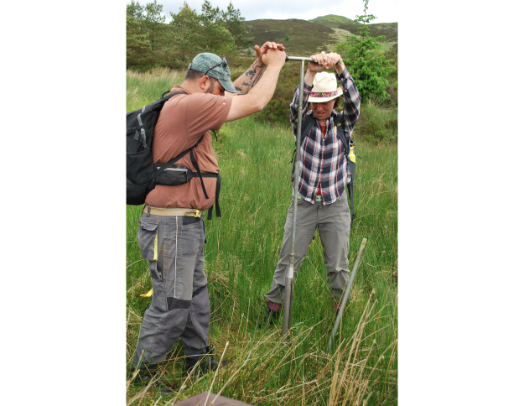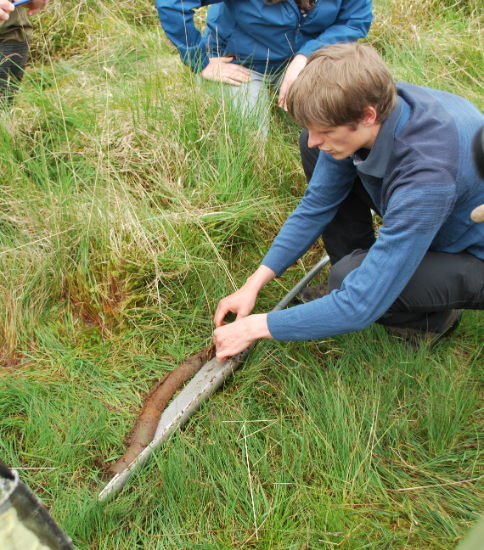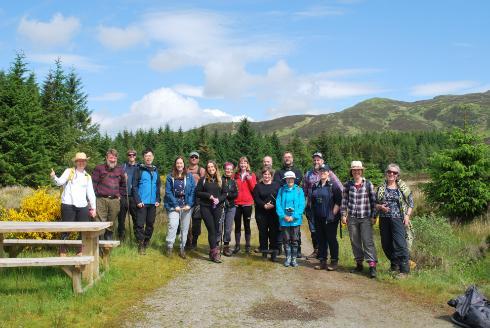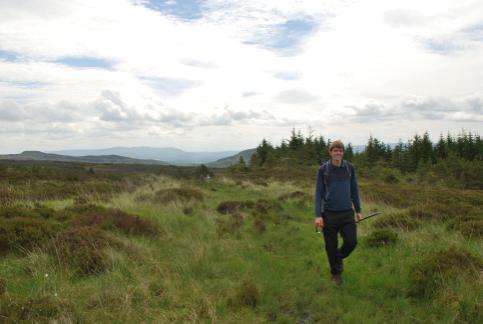Peatland Perspectives, Past and Present
Published: 11 July 2022
Dr Michael R. Muir | Reflections on the “Discipline Hopping Peatlands and Wetlands Group” workshops, Scottish National Galleries: 17th May, and Scottish Centre for Ecology and the Natural Environment (SCENE): 15-17th June 2022
The fact that peatlands provide many vital functions as part of the global climate and biosphere systems is widely accepted today, with our understanding of these complex habitats continually expanding thanks to new and innovative research. Examples of the importance of peatlands globally include being a significant reservoir of carbon for thousands of years1,2, providing a global drinking water resource3, and being home to a unique assortment of organisms specially adapted to survive in the often acidic, oxygen-poor, nutrient-poor soil conditions and in the wet and exposed climatic conditions in which peatlands thrive4.
However, our understanding and acceptance of these globally important aspects of peatlands has only developed relatively recently, and attitudes towards peatlands have shown considerable changes throughout history. These changes in the perception of peatlands over time were highlighted in a recent series of cross-disciplinary workshops hosted by the University of Glasgow. The NERC funded “Discipline Hopping Peatlands and Wetlands Group” has brought together academics and stakeholders with backgrounds in Art, Archaeology, Biology and Environmental Science to discuss and share their work related to peatlands and wetlands, allowing participants to learn about the interpretations of these unique landscapes offered by different disciplines. These perspectives have been shared at recent workshops at the National Galleries of Scotland (NGS) in Edinburgh and at the Scottish Centre for Ecology and the Natural Environment (SCENE), on the banks of Loch Lomond.
During the workshops, contributions from the fields of archaeology and art history provided an interpretation of how peatlands have been perceived by the people who lived around them for thousands of years into the past. Evidence that our ancestors of several thousand years ago viewed peatlands and bogs as spiritual and mysterious places comes from precious artefacts deposited as offerings into peatlands such as intricately detailed jewelry, musical instruments and food items, as well as from the “bog bodies” of people who were buried in bogs, perhaps as part of a ritual. Other items, such as agricultural tools, clothing and shoes, provide an insight into the daily lives of people living closely with peatlands, and highlight the close connection between people and the landscape in the past5. From the 17th century onwards, a revolution in the way agriculture was conducted brought with it a distinct change in the way peatlands were considered. Peatlands were often seen as areas of wasteland or “terribly grim, ghastly moor,” as a contemporary review described the subject of Peter Graham’s (1836 –1921) painting “O’er Moor and Moss” (1867). Peatlands were considered to be effectively worthless without ‘improvement’ to make them profitable for agriculture or management for sport hunting. The idea that the value of peatlands was in their use as a resource is one which persisted into the 20th and even 21st centuries, with peatlands being drained for forestry or dug up for commercial compost manufacture7.
The historic perspective from art and archaeology highlights the relatively rapid change in the way peatlands are perceived and valued today, with a greater focus on peatland protection and restoration. Examples include the recent UK government consultation on banning the sale of peat-based compost for amateur gardeners8 and the funding recently made available for peatland restoration in Scotland9,10, both of which go some way to safeguard the future of peatlands in the UK. However, this does not mean that the problems facing peatlands globally are diminishing, with the impact of climate change and continued exploitation of peat as a resource still putting immense pressure on these fragile ecosystems 11,12.
In order to ensure these delicate landscapes can continue to survive and thrive into the future, it is important to understand the wide-reaching impact they have had on historical and contemporary global climate and society. The broad extent of these impacts has been demonstrated in these workshops, with aspects including cultural heritage, land ownership and valorization, scientific advances, scientific communication, and habitat protection and restoration discussed, to name a few. The varied perspectives presented highlighted the ways in which these sometimes revered and sometimes maligned landscapes have been perceived by those around them throughout history. Importantly, the workshops highlight how a cross-disciplinary perspective is vital in helping us to tackle the challenges facing peatlands and wetlands today. With more activities planned by the Discipline Hopping Peatlands and Wetlands Group, it is certain that these workshops will influence the research and activities of those in attendance and contribute to the ever-changing perspectives of peatlands into the future.
- Hugelius G, Loisel J, Chadburn S, et al. Large stocks of peatland carbon and nitrogen are vulnerable to permafrost thaw. Proc Natl Acad Sci USA. 2020;117(34):20438-20446. doi:10.1073/PNAS.1916387117/SUPPL_FILE/PNAS.1916387117.SD06.XLSX
- Beaulne J, Garneau M, Magnan G, Boucher É. Peat deposits store more carbon than trees in forested peatlands of the boreal biome. Scientific Reports. 2011;11:2657. doi:10.1038/s41598-021-82004-x
- Xu J, Morris PJ, Liu J, Holden J. Hotspots of peatland-derived potable water use identified by global analysis. Nature Sustainability. Published online 2018. doi:10.1038/s41893-018-0064-6
- Rydin H, Jeglum JK. Diversity of life in peatlands. In: The Biology of Peatlands. Oxford University Press; 2015:21-47. doi:10.1093/ACPROF:OSOBL/9780199602995.003.0002
- Giles M. Exquisite things and everyday treasures. In: Bog Bodies. 1st ed. Manchester University Press; 2020:119-165. doi:10.7765/9781526150196.00011
- Graham P. O’er Moor and Moss | National Galleries of Scotland. Published 1867. Accessed June 20, 2022. https://www.nationalgalleries.org/art-and-artists/5638
- Litterick A, Bell J, Sellars A, Carfrae J. Rapid Evidence Assessment of the Alternatives to Horticultural Peat in Scotland.; 2019. doi:10.7488/era/71
- DEFRA, Natural England, Welsh Government, Pow R. Plans to phase out the use of peat in the amateur horticulture sector - GOV.UK. gov.uk. Published December 2021. Accessed June 20, 2022. https://www.gov.uk/government/news/plans-to-phase-out-the-use-of-peat-in-the-amateur-horticulture-sector
- NatureScot. Peatland ACTION Project. Published 2020. Accessed June 20, 2022. https://www.nature.scot/climate-change/nature-based-solutions/peatland-action-project
- Scottish Government. Funding to restore Scotland’s iconic peatlands. Published June 5, 2021. Accessed June 20, 2022. https://www.gov.scot/news/funding-to-restore-scotlands-iconic-peatlands/
- Ise T, Dunn AL, Wofsy SC, Moorcroft PR. High sensitivity of peat decomposition to climate change through water-table feedback. Nature Geoscience. 2008;1(11):763-766. doi:10.1038/ngeo331
- Swindles GT, Morris PJ, Mullan DJ, et al. Widespread drying of European peatlands in recent centuries. Nature Geoscience. 2019;12(11):922-928. doi:10.1038/s41561-019-0462-z
First published: 11 July 2022


Related links:
http://cca.academicblogs.co.uk/peatlands-and-wetlands/
https://brightedgedeep.arts.gla.ac.uk/
If you would like to contact Dr Muir about his research, please email: Michael.Muir@glasgow.ac.uk



